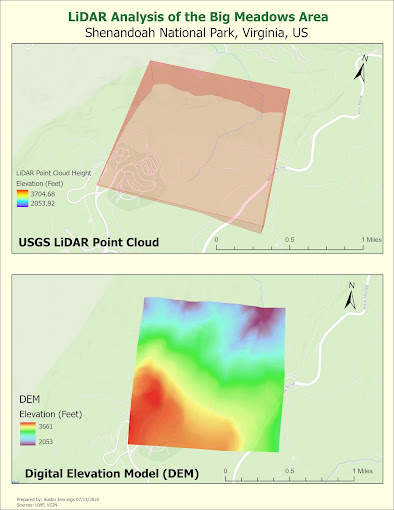Module 4 of Applications in GIS introduced us to a critical use of GIS, especially relevant to us here on the Emerald Coast, analyzing coastal flooding.
We started the lab by working with LiDAR data, learning the process of creating a usable Digital Elevation Model (DEM) from raw .laz files. We specifically used data collected pre- and post-Hurricane Sandy in a coastal area of Cape May County, New Jersey, to visualize the incredible force a storm such as this one can have on the landscape.
This direct comparison vividly demonstrated the immense force a storm like Sandy can have on the landscape, revealing extensive coastal reshaping, with clear evidence of significant erosion, loss of buildings, and even a dramatic breach of the barrier island. It also highlighted the critical challenge of accounting for post-disaster recovery and rebuilding efforts in our analysis.
Shifting gears a bit, we then focused directly on storm surge analysis in Cape May County, New Jersey. We learned how to define flood zones by reclassifying elevation data to show exactly which areas would be underwater during a specific surge height, like the 2-meter surge experienced during Hurricane Sandy. This allowed us to calculate the exact percentage of the county that might have been inundated, revealing that approximately 47% of Cape May County was likely affected.
Finally, we moved to Florida for what I found to be the most eye-opening part: a direct comparison of different elevation data sources. Using a 1-meter storm surge scenario, we stacked up flood predictions from a traditional USGS DEM against a more advanced, high-resolution LiDAR-derived DEM. This allowed us to pinpoint exactly how different data sources can change our understanding of flood risk, helping us to calculate and visualize critical errors of omission and commission (where one model got it right and the other didn't) between the two models. This analysis was key to understanding the real-world accuracy challenges in flood mapping.
However, our lab also made us aware of some key assumptions and simplifications. Assuming storm surges always cause uniform flooding is unrealistic, as water levels vary and can reach isolated low areas. We also didn't account for other causes like heavy rain, large waves, or tidal timing. For greater accuracy, advanced computer models should simulate different flood scenarios and water movement, considering all these factors.

















